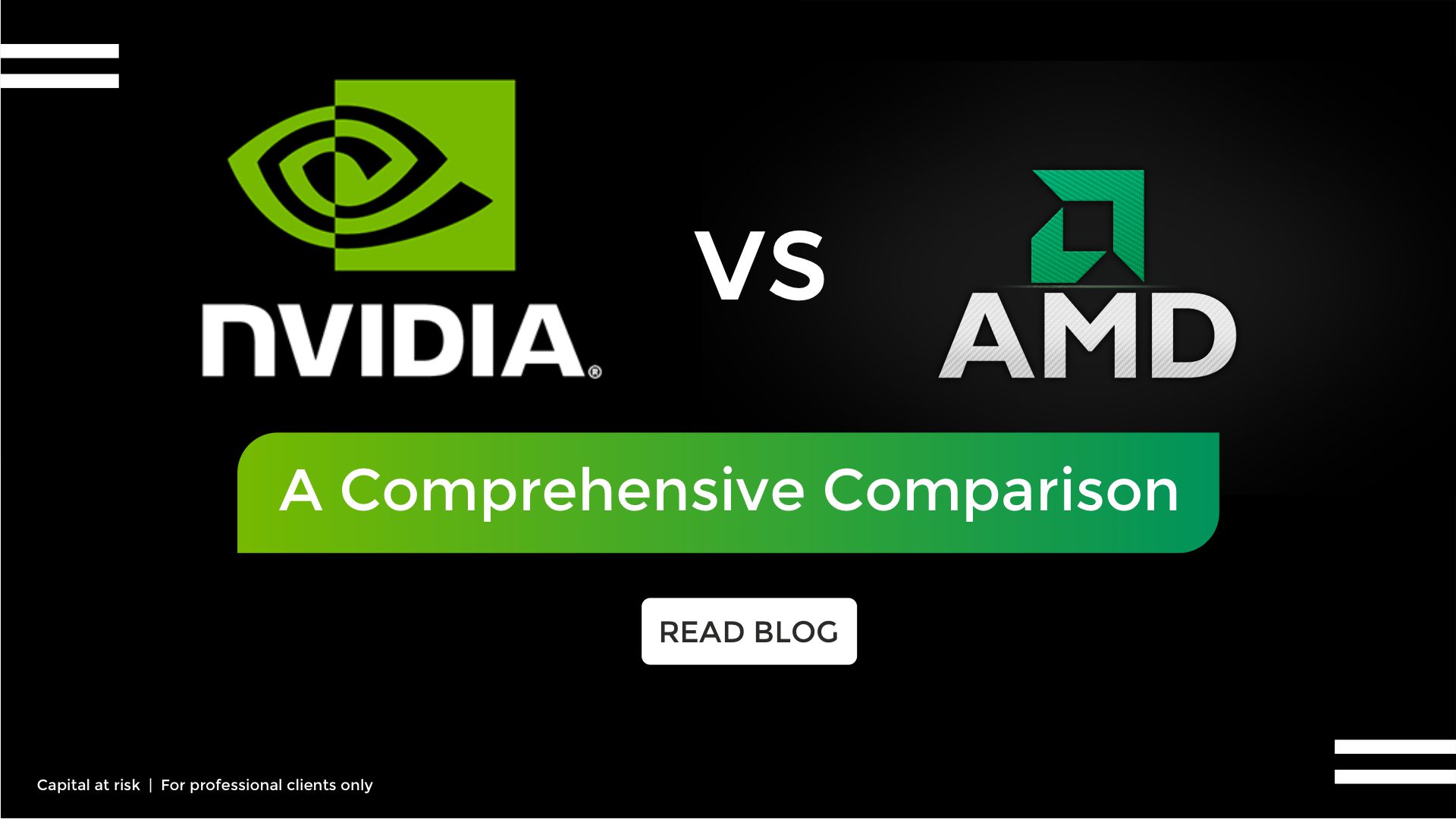Nvidia vs. AMD: A Comprehensive Comparison
Posted:
In the dynamic and fiercely competitive landscape of the tech industry, two giants stand at the forefront, each vying for supremacy in the realms of graphics cards and processors. Nvidia and AMD, household names among tech enthusiasts and professionals alike, have been locked in a decades-long battle, pushing the boundaries of innovation and performance to cater to the ever-evolving needs of consumers.
In this comprehensive article, we delve deep into the heart of this rivalry of AMD vs Nvidia, dissecting the strengths and weaknesses of both companies to help you make an informed decision.
Company Overview
Nvidia Corporation, a Silicon Valley powerhouse founded in 1993, has established itself as a dominant force in the world of graphics processing units (GPUs). With a rich history of innovation, Nvidia has consistently delivered cutting-edge GPU technology, revolutionizing gaming, artificial intelligence, and scientific computing. The company's GeForce series is a mainstay in the gaming community, known for its exceptional performance and advanced features, while its professional-grade GPUs, such as the Quadro and Tesla series, have become essential tools for researchers, data scientists, and creative professionals.
In contrast, Advanced Micro Devices (AMD), founded in 1969, has charted a distinct course in the semiconductor industry. AMD is renowned for its versatile product portfolio, spanning CPUs, GPUs, and APUs (Accelerated Processing Units). Over the years, AMD has challenged industry norms and offered compelling alternatives, fostering competition and innovation.
AMD's Ryzen processors have carved out a formidable presence in the CPU market, challenging Intel's long-standing dominance, while its Radeon graphics cards provide an appealing choice for gamers and content creators seeking high-performance graphics solutions. As both companies continue to evolve and compete, understanding their histories and core strengths is crucial in navigating the ever-expanding landscape of tech hardware.
Graphics Cards Comparison
In the realm of graphics cards, Nvidia and AMD have been engaged in an ongoing battle for supremacy, each striving to push the boundaries of visual computing. Let's delve into a detailed comparison of their graphics card offerings across key aspects:
Performance:
Nvidia's graphics cards have long held a reputation for delivering top-tier gaming performance. The Nvidia GeForce series, powered by the latest Ampere architecture (e.g., RTX 30 series), boasts impressive capabilities. These cards introduce cutting-edge features such as ray tracing and DLSS (Deep Learning Super Sampling), which significantly enhance gaming visuals and performance in supported titles. Nvidia's flagship cards, like the GeForce RTX 40 Series, GeForce RTX 30 Series, GeForce GTX 16 Series, dominate benchmarks and are ideal for gamers and content creators who demand uncompromising performance.
On the other hand, AMD's Radeon graphics cards, based on the RDNA 2 architecture, have made substantial strides in recent years. The Radeon RX 7800 XT and Radeon RX 7900 XTX, Radeon RX 7900 XT, compete admirably with Nvidia's offerings. AMD's emphasis on raw compute power and advanced features like Smart Access Memory (SAM) has garnered praise. In many gaming scenarios, AMD's GPUs offer comparable performance to their Nvidia counterparts, making them an attractive choice for those seeking high-performance graphics.
Features and Technologies:
Nvidia's RTX series introduces ray tracing, a groundbreaking technology that simulates real-time light interactions for unparalleled visual realism in supported games. DLSS leverages AI and machine learning to upscale lower-resolution images, delivering both better performance and image quality. Nvidia also offers advanced features like Nvidia Broadcast for content creators and Nvidia Reflex for competitive gamers, enhancing their respective workflows.
AMD counters with features like FidelityFX, a suite of visual effects and image quality enhancements, and SAM, which leverages the synergy between Ryzen CPUs and Radeon GPUs for performance gains in select games. AMD's focus on open standards makes their cards appealing to those who value an ecosystem that's not tied to proprietary technologies.
Price-to-Performance Ratio:
When it comes to price-to-performance, AMD has often been more competitive. Radeon graphics cards tend to offer solid gaming performance at a lower price point compared to Nvidia's offerings in the same performance tier. This makes AMD a compelling choice for budget-conscious gamers.
Nvidia's premium features, such as ray tracing and DLSS, are undoubtedly impressive but can drive up the cost of their cards. Whether Nvidia's added features justify the higher price is a subject of debate and largely depends on individual preferences and needs.
Processors Comparison
The battle between Nvidia and AMD extends beyond graphics cards into the realm of processors (CPUs), where they compete to power the heart of computing systems. Let's conduct a comprehensive comparison of their processors, considering key factors:
CPU Performance:
Nvidia's CPU offerings, particularly the Nvidia Grace Hopper architecture, have shown promise in the data center and high-performance computing (HPC) markets. These processors excel at parallel computing tasks and are designed for specialized workloads like artificial intelligence and scientific simulations. However, Nvidia CPUs are less common in consumer desktops and laptops, where AMD and Intel are more prevalent.
In contrast, AMD's Ryzen processors have emerged as strong contenders in the consumer CPU market. With their Zen architecture, AMD has closed the performance gap with Intel and, in some cases, even surpassed them. Ryzen processors are highly regarded for their excellent multi-core performance, making them well-suited for content creation, productivity tasks, and multitasking.
CPU Architecture:
Nvidia's CPU architectures, such as Grace Hopper, are tailored for specific applications like data centers and supercomputers. These architectures prioritize parallelism, energy efficiency, and large-scale computation, which are crucial for the specialized tasks they target.
AMD's Ryzen processors are built on the Zen architecture, which is a versatile microarchitecture designed for a wide range of computing needs. Zen CPUs excel in both single-threaded and multi-threaded performance, offering a balanced approach suitable for various applications, from gaming to content creation.
Integrated Graphics and APUs:
Nvidia typically doesn't incorporate integrated graphics into its consumer CPUs, as its primary focus is on high-performance computing and graphics processing. However, they have the Nvidia GeForce NOW service, which allows gaming via cloud streaming.
AMD, on the other hand, is known for its APUs (Accelerated Processing Units) that combine CPU and Radeon graphics on a single chip. This integration provides budget-friendly options for gamers and general users who don't require dedicated graphics cards.
Price-to-Performance Ratio:
AMD's Ryzen processors often offer a compelling price-to-performance ratio. With competitive pricing across various CPU tiers, AMD has challenged Intel's long-standing dominance in the consumer CPU market. Gamers and content creators on a budget can find excellent value in AMD's Ryzen lineup.
Nvidia CPUs, being more specialized and less prevalent in consumer markets, may not always be the most cost-effective choice for typical desktop or laptop users. Their pricing tends to reflect their focus on high-performance computing and specialized applications.
In summary, Nvidia and AMD each have their strengths in the CPU market. Nvidia's processors excel in specialized applications like AI and HPC, while AMD's Ryzen processors offer competitive performance and value for mainstream consumers. When choosing between them, consider your specific use cases, budget, and the availability of compatible hardware and software.
Future Developments and Roadmap
The technology landscape is ever evolving, and both Nvidia and AMD are continually working on future developments and product roadmaps to maintain their competitive edge. Here's a glimpse into what the future may hold for these two tech giants:
Nvidia:
- GPU Innovations: Nvidia is expected to continue advancing its GPU technology. Future iterations of the GeForce RTX series may bring even more powerful GPUs with enhanced ray tracing capabilities and AI-driven features, further elevating gaming, and content creation experiences.
- AI and Data Center: Nvidia's focus on AI and data center solutions will likely intensify. Expect developments in the A100 and future GPU architectures, catering to the growing demand for AI training and inference tasks in industries like healthcare, finance, and autonomous vehicles.
- Automotive: Nvidia's presence in the automotive sector with the NVIDIA Drive platform will likely continue to expand. They may work on more advanced autonomous driving solutions and partnerships with automakers.
- Quantum Computing: Nvidia has shown interest in quantum computing. While it's a nascent field, Nvidia may reveal advancements in quantum computing hardware or software in the coming years.
AMD:
- CPU Advancements: AMD is expected to refine its Zen architecture, potentially introducing Zen 4 or later iterations. These CPUs will likely continue to focus on improved single-threaded and multi-threaded performance, making them even more competitive in consumer and enterprise markets.
- Graphics Technologies: AMD's RDNA architecture will likely evolve to compete more effectively with Nvidia's GPUs. Enhancements in ray tracing capabilities and AI features can be anticipated.
- Data Center: AMD's EPYC server processors are gaining traction in data centers. They may expand their presence in this market, leveraging their high core counts and energy efficiency to challenge Intel's dominance further.
- Mobile and Embedded Solutions: AMD may expand its offerings in the mobile and embedded markets, including partnerships with laptop and device manufacturers.
- Integration with ARM: Following its acquisition of ARM, AMD may explore ways to integrate ARM technology into its CPU and GPU products, potentially leading to innovative, power-efficient solutions.
- Advanced Manufacturing: Like Nvidia, AMD may explore advanced semiconductor manufacturing processes, potentially transitioning to smaller nanometer nodes for improved efficiency and performance.
Conclusion
In the perennial rivalry between Nvidia and AMD, consumers find themselves presented with a wealth of choices and innovation across the realms of graphics cards and processors. Nvidia's relentless pursuit of cutting-edge GPU technology has redefined gaming experiences, while AMD's Ryzen processors have challenged the status quo in the CPU market. As we've explored the strengths of each company in this comparison, it's essential to remember that the choice between them depends on your unique needs and preferences.
Whether you're a gamer seeking the pinnacle of visual fidelity or a professional demanding uncompromising performance, both Nvidia and AMD offer compelling solutions. The decision ultimately comes down to a nuanced understanding of their respective strengths, your budget, and the ecosystem that aligns best with your computing requirements. As these tech titans continue to innovate and compete, the future promises even more exciting advancements, setting the stage for an ever-evolving landscape of computing excellence.
NVIDIA ETPs by GraniteShares
| Product name | Ticker | ||
|---|---|---|---|
| USD | EUR | GBX | |
DISCLAIMER
This is a disclaimer stating that all trading and investing comes with risks. Always do your research and do not invest more than you can afford to spend.
GraniteShares accepts no responsibility for any loss or damage resulting directly or indirectly from the use of this blog or the contents.
This blog does not constitute an offer to buy or sell or a solicitation of an offer to buy securities in any company. Nothing contained herein constitutes investment, legal, tax or other advice nor is to be relied upon in making an investment or other decision. No recommendation is made positive or otherwise, regarding individual securities or investments mentioned herein. Any summary list of risk factors does not purport to be a complete enumeration or explanation of the risks involved in a particular investment. Prospective clients must consult with their own legal, tax and financial advisers before deciding to invest. This email contains the opinions of the author and such opinions are subject to change without notice. The source of data is GraniteShares unless otherwise stated. No guarantee is made to the accuracy of the information provided which has been obtained from sources believed to be reliable. This email and the information contained herein is intended only for the use of persons (or entities they represent) to whom it has been provided. Past performance is not a reliable indicator of future results. The value of an investment may go down as well as up and can result in losses, up to and including a total loss of the amount initially invested. Investments may involve numerous risks including, among others, company risks, general market risks, credit risks, foreign exchange risks, interest rate risks, geopolitical risks and liquidity risks. Please note that GraniteShares short and leveraged Exchange Traded Products are for sophisticated investors.


